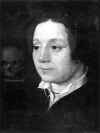
Catherine CHAMPERNOWNE
(Kate ASHLEY)
Died: 18 Jul 1565
Father: John CHAMPERNOWNE of Dartington (Sir)
Mother: Margaret COURTENAY
Married: John ASHLEY (Sir)
Catherine Ashley
by an unknown artist
In the collection of The Lord Hastings
| Her birth year
and parentage are uncertain. Some sources say she was
daughter of Sir John Champernowne of Dartington and Margaret
Courtenay. She may have been from another branch of the
family altogether. A letter
from Kate to Lord Cromwell written in
1536 makes reference to her
father, saying he "has much to do with the little living he has". The implication is that this Champernowne was still alive and
was not well-to-do. This seems to eliminate both Sir Phillip, who was
wealthy, and Sir John, who had died thirty-three years earlier, as
candidates to be her father. In addition, no contemporary records refer to
Joan Denny and Kat Astley as sisters.
Whatever her origins, she was appointed as a waiting gentlewoman to the Princess Elizabeth in Jul 1536. By the end of 1537 she had become her governess. In 1545 Kat married John Ashley, Elizabeth's senior gentleman attendant. In 1547, when Henry VIII died, the household was combined with that of the Queen Dowager Catherine Parr at Chelsea. While there, Kate permitted her charge to go to a party on the Thames at night. The Lord Protectorís wife, Anne Stanhope, declared that she was not fit to have governance of the kingís daughter. |
Sir John Ashley |
After the Queen Dowagerís death, Kate seems to have believed that a match between the Lord Admiral and the Princess could be arranged. She journeyed to London in Dec 1548 to meet with Seymour, and there she heard gossip that alarmed her. Some related to the Admiral's political activities, some to his interest in the Lady Elizabeth. Mrs Cheke and Lady Tyrwhitt, a relative of Catherine Parr, told the governess that it was still supposed that he had retained the Queen's maids for Elizabeth's benefit, and many were saying openly that he would soon be paying court to her.
Then the Protector's wife summoned Kat to court and berated her soundly for becoming over-friendly with the Admiral. She found great faults with Mrs Ashley because she had heard that, some time before, whilst they were still in the Queen's household, the governess had allowed Elizabeth to accompany Seymour on an evening trip down the Thames by barge without a chaperon. 'You are not worthy to have the governance of a king's daughter... Another shall have your place' she shrilled. Ashley hurried home to Hatfield finally convinced that now was not the time to urge a marriage between the Admiral and Lady Elizabeth. She told Elizabeth that such a thing might not be possible 'till the King's Majesty came to his own rule', for it appeared that neither 'my Lord Protector's Grace nor the Council would suffer a subject to have her'. It would be better therefore if she did not set her mind on this marriage, 'seeing the unlikelihood of it'; instead, she should 'hold herself at the appointment of my lords of the Council'. But Elizabeth had already decided upon this course; one scare had been enough for her, and she was well aware of what was at stake. But would Mrs Ashley follow her own advice?
On 21 Jan 1549, Sir Anthony Denny arrested Kate at Hatfield and conducted her to the Tower, for possible involvance in the Seymour plot. She finally confessed in Feb, but to nothing treasonous, and was released 13 days before Seymour's execution. By Aug she had returned to Hatfield.
During Mary's reign, Kateís husband went into exile but she remained with the Princess until Elizabeth was imprisoned in the Tower in 1554. She was allowed to rejoin her in Oct 1555, but shortly thereafter a search of Somerset House unearthed a coffer full of seditious books and papers and she was arrested in May 1556. This time she spent three months in Fleet Prison and after her release was forbidden to see Elizabeth Tudor again. When Mary Tudor died the order was recinded and Kate was made First Lady of the Bedchamber. She may also have served as Mother of Maids until 1562. She was much sought after as a source of information about the Queen and as a means of asking favors of the sovereign.
Her death in the summer of 1565 distressed Elizabeth greatly.
 to Bios
Page
to Bios
Page |
|
 to Peerage Page
to Peerage Page |
 to Home Page
to Home Page |